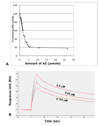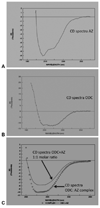Yeast ornithine decarboxylase and antizyme form a 1:1 complex in vitro: purification and characterization of the inhibitory complex
- PMID: 21295540
- PMCID: PMC3064986
- DOI: 10.1016/j.bbrc.2011.01.113
Yeast ornithine decarboxylase and antizyme form a 1:1 complex in vitro: purification and characterization of the inhibitory complex
Abstract
Saccharomyces cerevisiae antizyme (AZ) resembles mammalian AZ in its mode of synthesis by translational frameshifting and its ability to inhibit and facilitate the degradation of ornithine decarboxylase (ODC). Despite many studies on the interaction of AZ and ODC, the ODC:AZ complex has not been purified from any source and thus clear information about the stoichiometry of the complex is still lacking. In this study we have studied the yeast antizyme protein and the ODC:AZ complex. The far UV CD spectrum of the full-length antizyme shows that the yeast protein consists of 51% β-sheet, 19% α-helix, and 24% coils. Surface plasmon resonance analyses show that the association constant (K(A)) between yeast AZ and yeast ODC is 6×10(7) (M(-1)). Using purified His-tagged AZ as a binding partner, we have purified the ODC:AZ inhibitory complex. The isolated complex has no ODC activity. The molecular weight of the complex is 90 kDa, which indicates a one to one stoichiometric binding of AZ and ODC in vitro. Comparison of the circular dichroism (CD) spectra of the two individual proteins and of the ODC:AZ complex shows a change in the secondary structure in the complex.
Published by Elsevier Inc.
Figures




Similar articles
-
Critical factors governing the difference in antizyme-binding affinities between human ornithine decarboxylase and antizyme inhibitor.PLoS One. 2011 Apr 28;6(4):e19253. doi: 10.1371/journal.pone.0019253. PLoS One. 2011. PMID: 21552531 Free PMC article.
-
A unified pathway for the degradation of ornithine decarboxylase in reticulocyte lysate requires interaction with the polyamine-induced protein, ornithine decarboxylase antizyme.Eur J Biochem. 1994 Dec 1;226(2):547-54. doi: 10.1111/j.1432-1033.1994.tb20079.x. Eur J Biochem. 1994. PMID: 8001569
-
Characterization of ornithine decarboxylase and regulation by its antizyme in Thermus thermophilus.Mol Cell Biochem. 1999 May;195(1-2):55-64. doi: 10.1023/a:1006984618465. Mol Cell Biochem. 1999. PMID: 10395069
-
Degradation of ornithine decarboxylase by the 26S proteasome.Biochem Biophys Res Commun. 2000 Jan 7;267(1):1-6. doi: 10.1006/bbrc.1999.1706. Biochem Biophys Res Commun. 2000. PMID: 10623564 Review.
-
The antizyme family for regulating polyamines.J Biol Chem. 2018 Nov 30;293(48):18730-18735. doi: 10.1074/jbc.TM118.003339. Epub 2018 Oct 24. J Biol Chem. 2018. PMID: 30355739 Free PMC article. Review.
Cited by
-
Polyamine metabolism in fungi with emphasis on phytopathogenic species.J Amino Acids. 2012;2012:837932. doi: 10.1155/2012/837932. Epub 2012 Aug 22. J Amino Acids. 2012. PMID: 22957208 Free PMC article.
References
-
- Tabor CW, Tabor H. Polyamines. Annu Rev Biochem. 1984;53:749–790. - PubMed
-
- Cohen SS. A Guide to the Polyamines. New York: Oxford Univ. Press; 1998. pp. 1–595.
Publication types
MeSH terms
Substances
Grants and funding
LinkOut - more resources
Full Text Sources
Molecular Biology Databases
Research Materials

